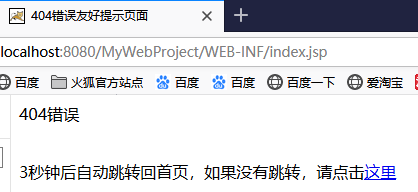1.JSP指令简介
JSP指令是为JSP引擎设计的,它们并不直接产生任何可见输出,而只是告诉引擎如何处理JSP页面中的其余部分。
在JSP 2.0规范中共定义了三个指令:page指令,Include指令,taglib指令。
JSP指令的基本语法格式:
例如:
如果一个指令有多个属性,这多个属性可以写在一个指令中,也可以分开写。
例如:
也可以写作:
2.page指令
page指令用于定义JSP页面的各种属性,无论page指令出现在JSP页面中的什么地方,它作用的都是整个JSP页面,为了保持程序的可读性和遵循良好的编程习惯,page指令最好是放在整个JSP页面的起始位置。
JSP 2.0规范中定义的page指令的完整语法:
[ language="java" ]
[ extends="package.class" ]
[ import="{package.class | package.*}, ..." ]
[ session="true | false" ]
[ buffer="none | 8kb | sizekb" ]
[ autoFlush="true | false" ]
[ isThreadSafe="true | false" ]
[ info="text" ]
[ errorPage="relative_url" ]
[ isErrorPage="true | false" ]
[ contentType="mimeType [ ;charset=characterSet ]" | "text/html ; charset=ISO-8859-1" ]
[ pageEncoding="characterSet | ISO-8859-1" ]
[ isELIgnored="true | false" ]
%>
2.1 import属性
在jsp页面中,jsp引擎会自动导入下面的包和类:
java.lang.*
javax.servlet.*
javax.servlet.jsp.*
javax.servlet.http.*
可以在一条page指令引入多个类和包,其中的每个包和类之间使用逗号分隔开,例如,
2.2 errorPage属性
errorPage属性的设置值必须使用相对路径,如果以“/”开头,表示相对于当前Web应用程序的根目录(注意不是站点根目录),否则,表示相对于当前页面。
可以在web.xml文件中使用元素为整个Web应用程序设置错误处理页面。
元素有3个子元素,、、
子元素指定错误的状态码,例如:404
子元素指定异常类的完全限定名,例如:java.lang.ArithmeticException
子元素指定以“/”开头的错误处理页面的路径,例如:/ErrorPage/404Error.jsp
如果设置了某个JSP页面的errorPage属性,那么在web.xml文件中设置的错误处理将不对该页面起作用。
jsperrorPage的相对路径,“/”表示当前web应用程序的根目录(WebRoot),“./”代表当前目录(即当前文件所在的目录),“../”代表当前文件所在目录的上一级目录。
例如有以下的工程目录结构:

testA.jsp中page指令的errorPage路径为:
即路径"/jspTest/error.jsp"为“WebRoot/jspTest/error.jsp”。
使用errorPage属性可以指明出错后跳转的错误页面,比如如下的testA.jsp代码:
String path = request.getContextPath();
String basePath = request.getScheme()+"://"+request.getServerName()+":"+request.getServerPort()+path+"/";
%>
My JSP 'testA.jsp' starting pageint i=2/0;
%>
int i=2/0,显然出错,第二行page指令的errorPage属性指明出错后跳转到error.jsp文件,error.jsp的内容为:
String path = request.getContextPath();
String basePath = request.getScheme()+"://"+request.getServerName()+":"+request.getServerPort()+path+"/";
%>
My JSP 'error.jsp' starting pagePrintWriter outs=response.getWriter();
outs.write("出错啦!");
%>
运行结果如下:

2.3 在web.xml中使用标签为整个web应用设置错误处理页面
例如,使用标签配置针对404错误的处理页面,在web.xml中的配置如下:
xmlns="http://java.sun.com/xml/ns/javaee"
xmlns:xsi="http://www.w3.org/2001/XMLSchema-instance"
xsi:schemaLocation="http://java.sun.com/xml/ns/javaee
http://java.sun.com/xml/ns/javaee/web-app_3_0.xsd">
index.jsp
404
/jspTest/error.jsp
要跳转的error.jsp的代码如下:
404错误友好提示页面404错误
3秒钟后自动跳转回首页,如果没有跳转,请点击这里
当访问一个不存在的web资源时,就会跳转到在web.xml中配置的404错误处理页面error.jsp,

2.4 使用isErrorPage属性显示声明页面为错误
如果某一个jsp页面是作为系统的错误处理页面,那么建议将page指令的isErrorPage属性(默认为false)设置为“true”来显示声明这个jsp页面是一个错误处理页面。将error.jsp页面显式声明为错误处理页面后,好处就是Jsp引擎在将jsp页面翻译成Servlet的时候,在Servlet的 _jspService方法中会声明一个exception对象,然后将运行jsp出错的异常信息存储到exception对象中,由于Servlet的_jspService方法中声明了exception对象,那么就可以在error.jsp页面中使用exception对象,这样就可以在Jsp页面中拿到出错的异常信息了。如果没有设置isErrorPage="true",那么在jsp页面中是无法使用exception对象的。
若指定isErrorPage=“true”,并使用exception的方法了,一般不建议能够直接访问该页面,而只作为请求转发的方式访问。
Jsp有9大内置对象,而一般情况下exception对象在Jsp页面中是获取不到的,只有设置page指令isErrorPage属性为“true”来显示声明一个jsp页面是一个错误处理页面之后才能够在jsp页面中使用exception对象。
3.include指令
在JSP中对于包含有两种语句形式:@include指令和指令
3.1 @include指令
include指令用于引入其它JSP页面,如果使用include指令引入了其它JSP页面,那么JSP引擎将把这两个JSP翻译成一个servlet。所以include指令引入通常也称之为静态引入。
语法:,其中的file属性用于指定被引入文件的路径。路径以“/”开头,表示代表当前web应用。
例如:
includeTest1.jsp
String path1 = request.getContextPath();
String basePath1 = request.getScheme()+"://"+request.getServerName()+":"+request.getServerPort()+path1+"/";
%>
My JSP 'includeTest.jsp' starting page"includeTest1.jsp's content"
includeTest2.jsp
String path = request.getContextPath();
String basePath = request.getScheme()+"://"+request.getServerName()+":"+request.getServerPort()+path+"/";
%>
My JSP 'includeTest2.jsp' starting page"includeTest2.jsp's content"
includeTest1.jsp使用将includeTest2.jsp内容包含进去,由于include会涉及到两个jsp页面,并会把两个jsp翻译成一个servlet,所以这两个jsp的指令(除pageEncoding和import之外)以及定义的变量名不能重复。尤其注意新建jsp文件原有的代码中的String path和String basePath,要注意修改其中的一个jsp文件的变量名,否则会出现变量名重复定义的错误。如下就是include includeTest2.jsp之后转换成的includeTest1_jsp类的源代码。
/*
* Generated by the Jasper component of Apache Tomcat
* Version: Apache Tomcat/8.5.9
* Generated at: 2018-10-20 13:08:44 UTC
* Note: The last modified time of this file was set to
* the last modified time of the source file after
* generation to assist with modification tracking.
*/
package org.apache.jsp.jspTest;
import javax.servlet.*;
import javax.servlet.http.*;
import javax.servlet.jsp.*;
import java.util.*;
import java.util.*;
public final class includeTest1_jsp extends org.apache.jasper.runtime.HttpJspBase
implements org.apache.jasper.runtime.JspSourceDependent,
org.apache.jasper.runtime.JspSourceImports {
private static final javax.servlet.jsp.JspFactory _jspxFactory =
javax.servlet.jsp.JspFactory.getDefaultFactory();
private static java.util.Map _jspx_dependants;
static {
_jspx_dependants = new java.util.HashMap(1);
_jspx_dependants.put("/jspTest/includeTest2.jsp", Long.valueOf(1540040843018L));
}
private static final java.util.Set _jspx_imports_packages;
private static final java.util.Set _jspx_imports_classes;
static {
_jspx_imports_packages = new java.util.HashSet<>();
_jspx_imports_packages.add("javax.servlet");
_jspx_imports_packages.add("java.util");
_jspx_imports_packages.add("javax.servlet.http");
_jspx_imports_packages.add("javax.servlet.jsp");
_jspx_imports_classes = null;
}
private volatile javax.el.ExpressionFactory _el_expressionfactory;
private volatile org.apache.tomcat.InstanceManager _jsp_instancemanager;
public java.util.Map getDependants() {
return _jspx_dependants;
}
public java.util.Set getPackageImports() {
return _jspx_imports_packages;
}
public java.util.Set getClassImports() {
return _jspx_imports_classes;
}
public javax.el.ExpressionFactory _jsp_getExpressionFactory() {
if (_el_expressionfactory == null) {
synchronized (this) {
if (_el_expressionfactory == null) {
_el_expressionfactory = _jspxFactory.getJspApplicationContext(getServletConfig().getServletContext()).getExpressionFactory();
}
}
}
return _el_expressionfactory;
}
public org.apache.tomcat.InstanceManager _jsp_getInstanceManager() {
if (_jsp_instancemanager == null) {
synchronized (this) {
if (_jsp_instancemanager == null) {
_jsp_instancemanager = org.apache.jasper.runtime.InstanceManagerFactory.getInstanceManager(getServletConfig());
}
}
}
return _jsp_instancemanager;
}
public void _jspInit() {
}
public void _jspDestroy() {
}
public void _jspService(final javax.servlet.http.HttpServletRequest request, final javax.servlet.http.HttpServletResponse response)
throws java.io.IOException, javax.servlet.ServletException {
final java.lang.String _jspx_method = request.getMethod();
if (!"GET".equals(_jspx_method) && !"POST".equals(_jspx_method) && !"HEAD".equals(_jspx_method) && !javax.servlet.DispatcherType.ERROR.equals(request.getDispatcherType())) {
response.sendError(HttpServletResponse.SC_METHOD_NOT_ALLOWED, "JSPs only permit GET POST or HEAD");
return;
}
final javax.servlet.jsp.PageContext pageContext;
javax.servlet.http.HttpSession session = null;
final javax.servlet.ServletContext application;
final javax.servlet.ServletConfig config;
javax.servlet.jsp.JspWriter out = null;
final java.lang.Object page = this;
javax.servlet.jsp.JspWriter _jspx_out = null;
javax.servlet.jsp.PageContext _jspx_page_context = null;
try {
response.setContentType("text/html;charset=ISO-8859-1");
pageContext = _jspxFactory.getPageContext(this, request, response,
null, true, 8192, true);
_jspx_page_context = pageContext;
application = pageContext.getServletContext();
config = pageContext.getServletConfig();
session = pageContext.getSession();
out = pageContext.getOut();
_jspx_out = out;
out.write('\r');
out.write('\n');
String path1 = request.getContextPath();
String basePath1 = request.getScheme()+"://"+request.getServerName()+":"+request.getServerPort()+path1+"/";
out.write("\r\n");
out.write("\r\n");
out.write(""-//W3C//DTD HTML 4.01 Transitional//EN\">\r\n");
out.write("\r\n");
out.write("
\r\n");out.write("
out.print(basePath1);
out.write("\">\r\n");
out.write(" \r\n");
out.write("
My JSP 'includeTest.jsp' starting page\r\n");out.write(" \r\n");
out.write("\t\r\n");
out.write("\t\r\n");
out.write("\t \r\n");
out.write("\t\r\n");
out.write("\t\r\n");
out.write("\t\r\n");
out.write("\r\n");
out.write(" \r\n");
out.write(" \r\n");
out.write("
\r\n");out.write("
\"includeTest1.jsp's content\"
\r\n");out.write(" ");
out.write('\r');
out.write('\n');
String path = request.getContextPath();
String basePath = request.getScheme()+"://"+request.getServerName()+":"+request.getServerPort()+path+"/";
out.write("\r\n");
out.write("\r\n");
out.write(""-//W3C//DTD HTML 4.01 Transitional//EN\">\r\n");
out.write("\r\n");
out.write("
\r\n");out.write("
out.print(basePath);
out.write("\">\r\n");
out.write(" \r\n");
out.write("
My JSP 'includeTest2.jsp' starting page\r\n");out.write(" \r\n");
out.write("\t\r\n");
out.write("\t\r\n");
out.write("\t \r\n");
out.write("\t\r\n");
out.write("\t\r\n");
out.write("\t\r\n");
out.write("\r\n");
out.write(" \r\n");
out.write(" \r\n");
out.write("
\r\n");out.write("
\"includeTest2.jsp's content\"
\r\n");out.write(" \r\n");
out.write("\r\n");
out.write("\r\n");
out.write(" \r\n");
out.write("\r\n");
} catch (java.lang.Throwable t) {
if (!(t instanceof javax.servlet.jsp.SkipPageException)){
out = _jspx_out;
if (out != null && out.getBufferSize() != 0)
try {
if (response.isCommitted()) {
out.flush();
} else {
out.clearBuffer();
}
} catch (java.io.IOException e) {}
if (_jspx_page_context != null) _jspx_page_context.handlePageException(t);
else throw new ServletException(t);
}
} finally {
_jspxFactory.releasePageContext(_jspx_page_context);
}
}
}
可以看到,includeTest1.jsp和includeTest2.jsp页面的内容都使用out.write输出到浏览器了。运行includeTest1.jsp后,显示如下的结果:

使用@include可以包含任意的内容,文件的后缀是什么都无所谓。这种把别的文件内容包含到自身页面的@include语句就叫作静态包含,作用只是把别的页面内容包含进来,属于静态包含。
3.2 jsp:include指令
接jsp标签。





















 1万+
1万+











 被折叠的 条评论
为什么被折叠?
被折叠的 条评论
为什么被折叠?








